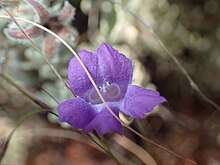Eremophila capricornica is a species of flowering plant in the figwort family, Scrophulariaceae and is endemic to Western Australia. It is a small shrub with woolly branches, grey, hairy leaves and mauve to lilac-coloured flowers with hairy sepals.
| Eremophila capricornica | |
|---|---|

| |
| Scientific classification | |
| Kingdom: | Plantae |
| Clade: | Tracheophytes |
| Clade: | Angiosperms |
| Clade: | Eudicots |
| Clade: | Asterids |
| Order: | Lamiales |
| Family: | Scrophulariaceae |
| Genus: | Eremophila |
| Species: | E. capricornica
|
| Binomial name | |
| Eremophila capricornica | |
Description
editEremophila capricornica is a shrub growing to 50–75 cm (20–30 in) high and wide with densely woolly branches. The leaves are arranged alternately, clustered near the ends of the branches, grey, lance-shaped with the narrower end towards the base, 8–12 mm (0.3–0.5 in) long and 3–4 mm (0.1–0.2 in) wide. The flowers are borne singly in leaf axils on a woolly stalk 2–3 mm (0.08–0.1 in) long. There are 5 lance-shaped, dark green to grey, hairy sepals which are 6–9 mm (0.2–0.4 in) long and 1.5–3 mm (0.06–0.1 in) wide. The petals are mauve to lilac-coloured, 15–20 mm (0.6–0.8 in) long and joined at their lower end to form a flattened, bell-shaped tube which is mostly glabrous inside and out. The 4 stamens are enclosed by the petal tube. Flowering time is mainly from June to August.[2][3]
Taxonomy and naming
editEremophila capricornica was first formally described by Bevan Buirchell and Andrew Brown in 2016 and the description was published in Nuytsia.[4][2] The specific epithet (capricornica) refers to the Tropic of Capricorn near which this species occurs.[2]
Distribution and habitat
editThis eremophila is found between Newman and Jigalong in the Gascoyne biogeographic region growing in Acacia shrubland with a grassy understorey.[2][3][5]
Conservation status
editEremophila capricornica has been classified as "Priority One" by the Government of Western Australia Department of Parks and Wildlife,[5] meaning that it is known from only one or a few locations which are potentially at risk.[6]
References
edit- ^ "Eremophila capricornica". Australian Plant Census. Retrieved 9 April 2020.
- ^ a b c d Buirchell, Bevan; Brown, Andrew P. (2016). "New species of Eremophila (Scrophulariaceae): thirteen geographically restricted species from Western Australia". Nuytsia. 27: 256–259.
- ^ a b Brown, Andrew; Buirchell, Bevan (2011). A field guide to the eremophilas of Western Australia (1st ed.). Hamilton Hill, W.A.: Simon Nevill Publications. p. 297. ISBN 9780980348156.
- ^ "Eremophila capricornica". APNI. Retrieved 14 April 2017.
- ^ a b "Eremophila capricornica". FloraBase. Western Australian Government Department of Biodiversity, Conservation and Attractions.
- ^ "Conservation codes for Western Australian Flora and Fauna" (PDF). Government of Western Australia Department of Parks and Wildlife. Retrieved 14 April 2017.
